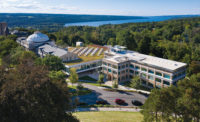Ithaca, New York
The natural environment of the Cornell campus is startling,' says Thom Mayne, of Morphosis, about the gorge-riven and forested terrain of the 149-year-old university in Ithaca, New York. So is his recently completed Bill & Melinda Gates Hall. The 101,500-square-foot structure perches like a giant metal bird on a sloping site near the historic center of the Ivy League institution. With this facility for the combined departments of the Faculty of Computing and Information Science, the architects placed a rectilinear volume on the southwest corner of the narrow 60,000-square-foot site, then mounted feathery stainless-steel perforated panels on its long north and south elevations and across the upper west facade. On this short end facing the street, Morphosis carved out the first two floors, creating a deep, partially cantilevered overhang for an entry plaza slightly elevated above grade. The sheltering arced soffit is clad in orange metal, giving it a sunlike vibrancy that is 'so helpful in fighting depression in the winter's dark, gray, snowy days,' says project principal Ung-Joo Scott Lee, who should know: he was once a student on this northern campus.
Eventually, too, another entrance will open on the south elevation overlooking a baseball field, which, according to the 2008 campus master plan, will be transformed into a three-sided quad for Gates and two new engineering buildings. Because of a grade change, the entrance for the five-story building would be accessed at the lower level, where a 151'seat lecture hall is located.
The main entrance opens onto a skylit atrium, 54 feet high, with orange fritted glass on the north and east. 'With the atrium and glass, the daylight and openness, we can feel connected to the various departments and people,' says Kavita Bala, a professor of computer science. 'It's a big difference in the quality of life for the students.' (Information-science students used to be stuck in rented spaces at the edge of the campus, while computer-science students were crammed into nearby engineering buildings.)
Behind the glazed atrium and stairwell is a rectangular block for teaching and research functions''an efficient chassis,' says university architect Gilbert Delgado. The volume houses labs, offices, conference and seminar rooms, informal lounges, and open collaboration spaces for the 500 undergraduate majors and 350 graduate students to come together. 'This is the workhorse,' says Mayne. 'The entrance and atrium are the architecture.' In creating the plan, a simple U shape with double-loaded corridors, the architects gently splayed and angled the walls along the hallways to inject a spatial dynamic into an otherwise formulaic grid.
Considering that Mayne and his firm Morphosis are currently designing the highly touted Academic Building for the Cornell NYC Tech campus on Roosevelt Island, in New York (to be completed in 2017), the opening of Gates Hall can be seen as a dry run. Both are devoted to computer technology and information systems'and both emphasize a fluidity of space to foster spontaneous interaction, communication, and collaboration'but the buildings' overall partis differ. As Mayne explains it, the design for the Roosevelt Island structure results from the commitment to create a net zero building, which determined the placement of an expansive roof of photovoltaics over a broad, open plan.
Although Gates is not energy-neutral, it is seeking LEED Gold status through the use of high-performance fritted and clear glazing, and the perforated metal feathers, which help reduce solar loads on the elongated south elevation in particular. In addition, Gates relies on radiant floors and a chilled-beam passive convection system, not to mention recycled and renewable building materials. But the design also was shaped by the constricted lot and the desire to give drama and an identity to this rather dead part of the Cornell campus'and with a tight construction budget ($425 a square foot).
While Cornell has a number of commendable 19th- and early 20th-century buildings, including Gothic Revival, Richardsonian Romanesque, and Collegiate Gothic styles, the postwar modernist period'which went on too long'left the campus with a slew of mediocre buildings, the engineering quad included. Gates Hall easily sparks up its dreary hodgepodge setting. There it sits, an economical, muscular, yet strangely elegant structure, like an abstract bird of prey with gleaming feathers, a radiantly colored neck, staunch legs, and very scary claws.
PeopleClient: Cornell University
Architect:
Personnel in architect's firm who should receive special credit:
Project Principal
Project Manager
Project Architect
Project Designer
Project Team
Project Assistants
Visualization
Consultants:
MEP/ Fire Protection:
Landscape Architect:
Sustainability:
Cost Estimator:
Façade:
Geotechnical:
Lighting:
Acoustics:
Audiovisual/IT:
Code:
Specifications:
Construction Team:
General Contractor
Photographer(s): Project cost: $60 million Construction cost: $42 million Size: 101,500 gross square feet Completion date: January 2014 |
Products
Structural system
Manufacturer of any structural components unique to this project:
Exterior cladding
Metal Panels:
Metal/glass curtain wall:
Precast concrete:
Moisture barrier:
Roofing
Glazing
Skylights:
Other:
Interior Glass Curtainwall:
Doors
Glass doors:
Metal doors:
Sliding doors:
Fire-control doors, security grilles:
Hardware
Closers:
Exit devices:
Pulls:
Interior finishes
Paneling:
Plastic laminate:
Solid surfacing:
Carpet:
Special interior finishes unique to this project:
Auditorium Acoustic Wall and Ceiling Panel:
Furnishings
Reception furniture:
Fixed seating:
Chairs:
Tables:
Lighting
Downlights:
Exterior:
Dimming System or other lighting controls:
Conveyance
Plumbing
Toilet:
Faucets:
Energy
Other unique products that contribute to sustainability: |































Post a comment to this article
Report Abusive Comment